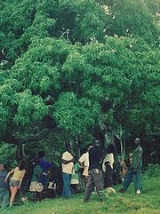
Accompong
Encyclopedia
Accompong is a historical maroon
village, located in the hills of St. Elizabeth Parish
in Jamaica
, consolidated by a treaty in 1739. It is located in one of the two areas where runaway slaves settled, originally with the Taínos, isolated enough to be safe first from the Spanish and then later from the British. The town of Accompong was named after the Maroon leader Accompong, who was the brother of a number of other Maroon leaders: Quao, Cuffy, Cudjoe, and Nanny, from an Ashanti family.
Cudjoe (also Kojo), a leader of the Maroons, is said to have united the Maroons in their fight for autonomy under the Kindah Tree - a huge, ancient mango tree that is still standing (2009). Accompong was founded in 1739 after the Maroons signed a peace treaty with the British at nearby "Peace Cave". The treaty granted the Maroons their long sought autonomy. However a second Maroon war
broke out in 1795. The Accompong Maroons remained neutral and the British left them alone. At the end of the war all the other Maroon settlements in Jamaica were destroyed, Accompong alone remained.
The fruitful Kindah Tree itself, with its sign proclaiming "We are Family", symbolizes the common kinship of the corporate creole community on its common land. In the 1990s the Myal Dance became a tourist attraction and a symbol of Jamaican nationhood, forged through a history of conflict and alliance.
mining.
Maroon (people)
Maroons were runaway slaves in the West Indies, Central America, South America, and North America, who formed independent settlements together...
village, located in the hills of St. Elizabeth Parish
Saint Elizabeth Parish, Jamaica
St. Elizabeth, one of Jamaica's largest parishes, is located in the southwest of the island, in the county of Cornwall. Its capital, Black River, is located at the mouth of the Black River, the longest on the island.-History:...
in Jamaica
Jamaica
Jamaica is an island nation of the Greater Antilles, in length, up to in width and 10,990 square kilometres in area. It is situated in the Caribbean Sea, about south of Cuba, and west of Hispaniola, the island harbouring the nation-states Haiti and the Dominican Republic...
, consolidated by a treaty in 1739. It is located in one of the two areas where runaway slaves settled, originally with the Taínos, isolated enough to be safe first from the Spanish and then later from the British. The town of Accompong was named after the Maroon leader Accompong, who was the brother of a number of other Maroon leaders: Quao, Cuffy, Cudjoe, and Nanny, from an Ashanti family.
History
In Accompong Town, rebel slaves and their descendants wrested land from the colonial plantation-military regime and transformed a marginal mountainous reservation, imposed by a colonial legal treaty, into a sacred landscape rooted in common land.Cudjoe (also Kojo), a leader of the Maroons, is said to have united the Maroons in their fight for autonomy under the Kindah Tree - a huge, ancient mango tree that is still standing (2009). Accompong was founded in 1739 after the Maroons signed a peace treaty with the British at nearby "Peace Cave". The treaty granted the Maroons their long sought autonomy. However a second Maroon war
Second Maroon War
The Second Maroon War of 1795-1796 was an eight month conflict between the Maroons of Trelawny Parish, Jamaica and the British. The other Maroon communities did not take part in this rebellion and their treaty with the British remained in force until Jamaica gained its independence in 1962.-The...
broke out in 1795. The Accompong Maroons remained neutral and the British left them alone. At the end of the war all the other Maroon settlements in Jamaica were destroyed, Accompong alone remained.
The fruitful Kindah Tree itself, with its sign proclaiming "We are Family", symbolizes the common kinship of the corporate creole community on its common land. In the 1990s the Myal Dance became a tourist attraction and a symbol of Jamaican nationhood, forged through a history of conflict and alliance.
Culture
The inhabitants of Accompong share practices and a culture similar to their African culture originating 200–300 years ago. Every January 6 (Cudjoe's birthday) at Accompong, descendants and friends of the Maroons come together at a festival in celebration of the treaty. In 2007, the festival took on a more political flavor, as attenders protested increased bauxiteBauxite
Bauxite is an aluminium ore and is the main source of aluminium. This form of rock consists mostly of the minerals gibbsite Al3, boehmite γ-AlO, and diaspore α-AlO, in a mixture with the two iron oxides goethite and hematite, the clay mineral kaolinite, and small amounts of anatase TiO2...
mining.
External links
- Accompong Town An informative site with information on the town of Accompong as well as the festival
- Jamaicaholics.com Things to see and do when visiting Accompong

